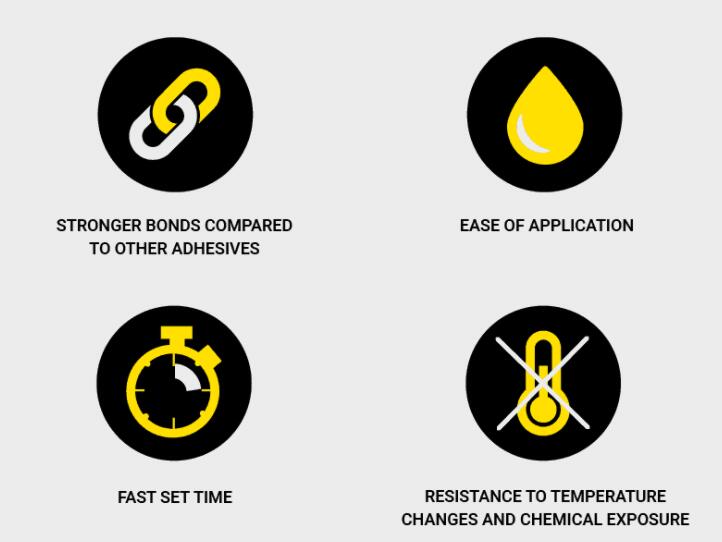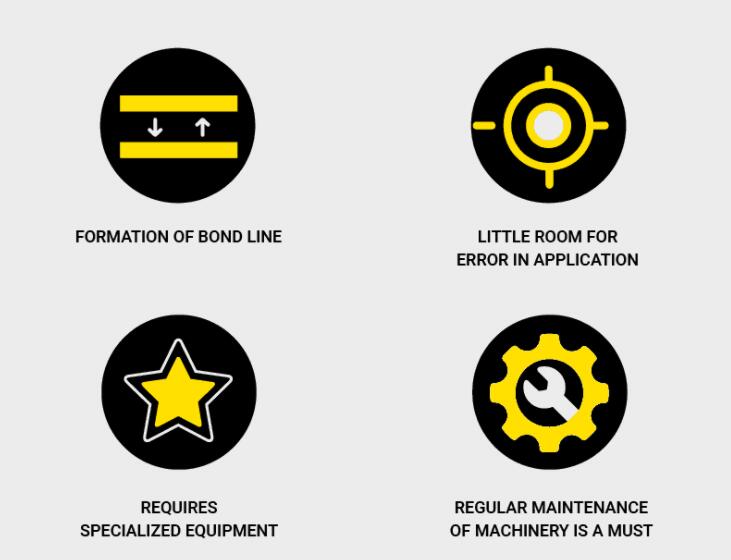When deciding what kind of adhesive to use for your manufacturing, packaging and labeling needs, you may consider a moisture-curing polyurethane hot melt adhesive (PUR). With their high bond strength, polyurethane hot melts can be an attractive option for many different kinds of adhesive applications. However, polyurethane hot melts are not without their disadvantages as well. Let’s take a closer look at the pros and cons of using polyurethane hot melts for your particular adhesive needs.

ADVANTAGES OF POLYURETHANE HOT MELT ADHESIVES
STRONGER THAN WATER-BASED & OTHER HOT-MELTS ADHESIVES:
PUR hot melt draws moisture from the substrates and the atmosphere and cures to form a bond that is stronger than most other adhesives, including water-based adhesives as well as other hot melt adhesive formulations.
SHORT LEARNING CURVE:
Because polyurethane hot melt adhesives are applied like other hot melt adhesives, using glue guns or similar equipment, operators can quickly get up to speed on applying best practices without having to learn all new processes and equipment.
FORMS A BOND QUICKLY:
Polyurethane hot melt works quickly to form an extremely strong bond, with a fast set time. This allows you to quickly and confidently move through the manufacturing or packaging process with less concern about weak bonds or shifting substrates.
OTHER ADVANTAGES:
Include strength, flexibility, temperature and chemical resistance. PUR can be used in a wide range of industries and has many applications.

DISADVANTAGES OF POLYURETHANE HOT MELT ADHESIVES
BOND LINE ISSUES:
Unlike water-based adhesives that soak into the substrate, polyurethane hot melt adhesives stay on the surface of the materials. Because of this, a bond line can be created, which may be aesthetically unappealing or may even affect the product or packaging itself. This bond line needs to be accounted for in the production process.
FAST SET TIME REQUIRES FAST WORK:
Because PUR hot melt adhesive bonds quickly, it’s imperative to get the application right the first time. Less “forgiving” than other types of adhesives, polyurethane hot melt gives you a short window of time to apply the adhesive and make adjustments. Once that window is closed, the substrates aren’t going anywhere, so if you don’t get the exact result you want the first time you may need to start over.
OTHER DISADVANTAGES:
PUR equipment is considered very specialized and comes with an additional cost, and the maintenance on the production line must be adhered to – they are not very forgiving.
IS POLYURETHANE HOT MELT RIGHT FOR YOUR NEEDS?
Clearly, there are a number of advantages and disadvantages when using PUR hot melts. Depending on your application, substrates and desired result, they may be a good choice for your business or you may be better served with a different type of adhesive.
Now It’s Your Turn
I hoped you enjoyed my detailed information for starting a business.
Now I want to hear from you:
Which parts from this post are you most excited to know ?
Are you going to know more other kinds of related products? Or do you want to do deep research on this line?
Let me know by leaving a quick comment.

